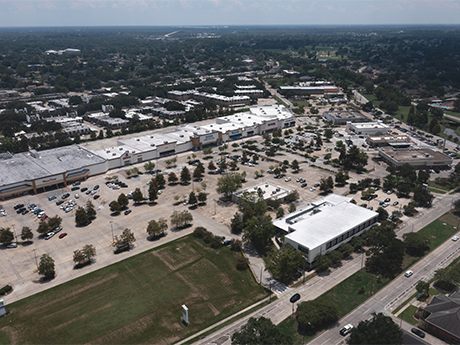The New Orleans retail market is in a state of flux like other markets across the country. The retail experience is changing for the end user, with an increase in online shopping, “try before you buy” customers and quicker walkthroughs. Retailers are left in an odd position, caught between experiential interactions with customers and trying to have them remember to purchase later at home.

While the retail market is changing, the Greater New Orleans area is different due to the scarcity of space available for new construction and a stable flow of stores closing or relocating. Our market creates a streamlined experience where consumers have “retail corners” they can visit to shop — such as downtown New Orleans, especially the iconic streets of Canal and Magazine — but also the suburbs that include Metairie, Elmwood and the Westbank.
With the concentrated shopping setup of the market, customers can shop more efficiently, and retail investors see the New Orleans market as a more demanding and creative place to build and open stores.
Submarket by submarket
The retail customer in New Orleans detests spending unneeded time in the car, so when customers can shop locally, get what they need and get it home, they often reward well-placed shopping areas with good product mixes. This is heavily evident in the Magazine Street and Westbank shopping corridors, as these retail shoppers experience obstacles to movement that other areas of town don’t readily face.

This makes their allocated shopping time more valuable in the eye of the retailer, as they have a captured customer, and provided they can deliver the experience that the customer wants, it will be attractive to retail shoppers and how they allocate their limited time.
On Magazine Street, hyper-local, focused shopping experiences are found at small retailers with curated collections of unique products, which also generates experiences for shoppers buying holiday gifts or non-locals wanting something to remember their time in the city.
These areas allow parking close to the intended destination, as opposed to a larger regional mall like Lakeside Shopping Center, which might have larger parking lots. Parking close to the destination allows shoppers in this niche sector to avoid longer drives, longer walks to the shops and excessive exposure to the elements.
The experience through small, converted houses, old world retail stores and repurposed, classical bank facades, attracts many brand concepts to this unique experience of where the old world meets the new. This clientele is looking for an encounter that cannot be found at a mall where streamlined, one-stop experiences with the same brands dominate, but rather a more stylized concept of product display and use.
The Westbank of New Orleans is a different, yet similarly purposed retail experience. Customers on this side of the river are well aware of the hassles and time commitments of crossing bridges, traffic timelines and adhering to their shopping goals. These customers are less focused on the experience of shopping but more on the efficiency of that experience. They know more about what they want and are more strategic in their location choices.
Centers in this area of town are more heavily focused on the synergistic aspect of store placement, product mix and ease of access. Shoppers at centers like Algiers Plaza at 4100 General De Gaulle Drive don’t need to drive an extended amount of time at multiple locations to cross every item off their list, as the retail mix helps to consolidate what shoppers are looking to buy.
In the pipeline
While the market in general is stable, major projects are underway to create new and modern shopping experiences for locals and visitors alike by relocating existing stores, closing underperforming ones or debuting new retail concepts.
Clearview City Center is undergoing a complete repositioning into a medical- and retail-focused destination, with added apartment housing, new stores and a brand new Ochsner Hospital complex that brings sophisticated medical services to the area.
The development of the River Market District is a large venture that will turn a rare space of vacant and undeveloped land close to the downtown corridor into a more vibrant area for people to live, work and shop, attracting convention goers, tourists and locals.
The redevelopment of Elmwood Shopping Center aims to reposition the large retail mix of stores as an open-air lifestyle center where customers can eat, shop and have a more modern destination-oriented experience.
Previously “sleepy” and underutilized areas, such as Tchoupitoulas Street in Uptown and the Marigny neighborhood east of the French Quarter, are beginning to see a new awakening as retail corridors with the repurposing of existing centers and development of small, localized retail strips heralding new concepts looking to enter the market.
Outside traditional New Orleans and its immediate suburbs, growing areas of commerce in Covington and Mandeville are benefiting from the availability of land for ground-up concepts that find it hard to fit into the more limited, denser areas.
One potential limitation to new development, retail rent increases and new store entry is the high price of insurance that the New Orleans market is facing. Landlords are seeing large annual increases to their insurance costs, which are becoming harder and harder to pass through to tenants as increases to rental rates.
The ultimate impact this will have on new development or redevelopment of existing centers is not yet fully known, but if not confronted and addressed will increasingly become a limiting factor to growth and market evolvement.
Investment activity
As owners reassess their portfolio allocations, and new buyers to the market seek exposure to the rapidly evolving Southeastern United States, retail investment sales are continuing to occur. With plenty of barriers to entry existing for wholesale redevelopment and new development, owners can feel assured that their investments won’t see constant new developments to compete with, like other urban environments within the region.
Furthermore, investors can feel safer with their investments due to the limited inventory of land available, as well as the political resistance to land use conversions due to the already low housing stock. Large-scale retail developments are years in the making and have become somewhat limited in their scope as they are highly unique to this market with little open land.
Velocity, in the true sense of speed of turnover in ownership, may not be as high as in other markets, but for those investors looking for product and have an eye for improving tenant mixes, they will find numerous opportunities to enter the market. They have the ability to reposition existing centers with relatively low added capital needed and unlock new value to both the owner and demographic base those centers serve.
Power and neighborhood center owners can reinvest capital into their centers through lighting, signage and façade improvements, as well as utilizing new technologies to drive product decisions, to support owner’s efforts to increase rents and help cover increasing costs to operate.
Classic situations where long-time family ownership resists new capital investment provide new buyers with the opportunity to have a new basis in a higher quality product, without the added cost of new construction. Sellers can take their newly unlocked capital, reinvest in other stable centers through 1031 exchanges, distribute to families as part of asset dissolution plans or in many cases enter into ground lease or joint venture partnerships with new capital that is looking to enter the market.
— By Chris Robertson, Senior Real Estate Analyst, and Stephanie Hilferty, SRSA Commercial Real Estate. This article was originally published in the October 2023 issue of Southeast Real Estate Business.


